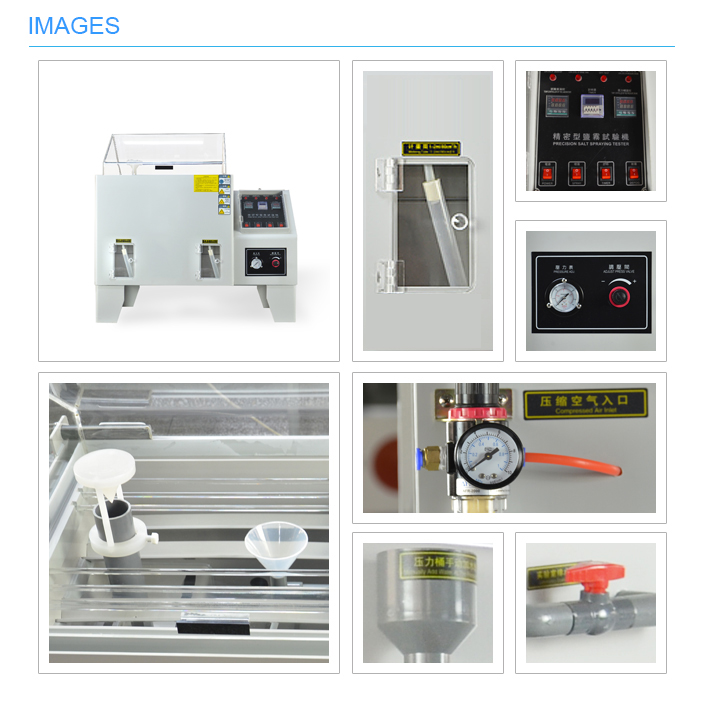About the Three Testing Methods of the GT-F50 Salt Spray Test Chamber
The GT-F50 Salt Spray Test Chamber, as an advanced environmental simulation device, plays a crucial role in industrial testing. It is primarily used to test the corrosion resistance of various materials' surfaces after electroplating, anodizing, painting, rust-proof oil treatments, and more. This article will explain in detail the three testing methods of the GT-F50 Salt Spray Chamber: Neutral Salt Spray Test (NSS), Acetic Acid Salt Spray Test (AASS), and Copper Accelerated Acetic Acid Salt Spray Test (CASS).

I. Overview of the GT-F50 Salt Spray Test Chamber
The Salt Spray Test Chamber, also known as a salt spray corrosion test chamber, aims to evaluate the corrosion resistance of materials by simulating a salt spray environment. It is suitable for testing the corrosion resistance of various surface treatments, including electroplating, anodizing, painting, and rust-proof oil. The GT-F50AB Salt Spray Chamber is specifically designed for conducting the Neutral Salt Spray Test (NSS), Acetic Acid Salt Spray Test (AASS), and Copper Accelerated Acetic Acid Salt Spray Test (CASS).
II. Neutral Salt Spray Test (NSS)
1. Principle:
1.1 The Neutral Salt Spray Test (NSS) is the most common salt spray test method. It uses a 5% sodium chloride solution with a pH value between 6.5 and 7.2.
1.2 This test simulates the corrosion environment under marine climate conditions and is widely used to assess the corrosion resistance of metals and their protective coatings.
2. Testing Process:
2.1 Salt spray is generated within the test chamber, exposing the test samples to the salt spray environment.
2.2 The duration of the test is determined by the material and standard requirements, typically ranging from 24 to 1000 hours.
3. Application:
3.1 NSS testing is suitable for various metal materials, including steel, aluminum, copper, and their alloys, as well as various coatings and platings.
3.2 This method is primarily used for preliminary assessments of general corrosion resistance.
III. Acetic Acid Salt Spray Test (ASS)
1. Principle:
1.1 The Acetic Acid Salt Spray Test (ASS) builds upon the NSS test by adding acetic acid to the sodium chloride solution, lowering the pH to between 3.1 and 3.3 to simulate a more severe acidic environment.
1.2 This test method is mainly used to simulate the corrosive effects of acidic pollutants in industrial atmospheres on materials.
2. Testing Process:
2.1 Test samples are exposed to an acidic salt spray environment in the AASS test, with the testing duration depending on the corrosion resistance requirements of the material.
2.2 The corrosion resistance is evaluated by observing the corrosion condition of the sample surface.
3. Application:
3.1 ASS testing is primarily used to test the corrosion resistance of electroplated layers, anti-corrosion coatings, and other materials in acidic environments.
3.2 It is particularly suitable for evaluating metal products and coatings used in industrial environments.
IV. Copper Accelerated Acetic Acid Salt Spray Test (CASS)
1. Principle:
1.1 The Copper Accelerated Acetic Acid Salt Spray Test (CASS) is an enhanced version of the AASS test. It adds a small amount of copper chloride to the solution to accelerate the corrosion process while maintaining a pH between 3.1 and 3.3.
1.2 CASS testing simulates more complex and harsh corrosion environments and is used for high-demand corrosion resistance testing.
2. Testing Process:
2.1 A copper-ion-containing acidic salt spray is generated in the test chamber, with test samples exposed to this environment.
2.2 The testing duration is relatively short but with high corrosion intensity, typically between 24 and 120 hours.
3. Application:
3.1 CASS testing is widely used in high-standard fields such as aviation, marine, and military industries to test the performance of high-demand anti-corrosion materials.
3.2 It is particularly suitable for evaluating the corrosion resistance of aluminum alloys, magnesium alloys, and their surface treatments.
V. Advantages of the GT-F50 Salt Spray Testing Machine
1. Material and Structure: The entire salt spray tester is made of 5mm imported gray PVC sheet. It uses advanced internal three-dimensional reinforcement technology, ensuring a strong structure, deformation resistance, acid and alkali resistance, high-temperature resistance, and aging resistance. It applies to various test specifications such as salt spray and copper acetate tests.
2. Heating Method: The test room uses a steam direct heating method, which ensures fast and uniform temperature rise, reducing standby time. The heating tube is made from titanium, offering high corrosion resistance.
3. Safety Features: Dual-function over-temperature protection is included. In case of over-temperature, it will display a warning and cut off the heater power to ensure safe use.
4. Automatic Features: The chamber includes an automatic spray exhausting device, allowing clear observation of the samples in the test room.
VI. Conclusion
As an advanced environmental simulation device, the GT-F50 Salt Spray Test Chamber provides reliable technical support for testing the corrosion resistance of materials through the NSS, AASS, and CASS tests. Whether for general corrosion testing or high-demand corrosion resistance evaluations, the Salt Spray Testing Machine demonstrates its excellent performance and wide application prospects.


